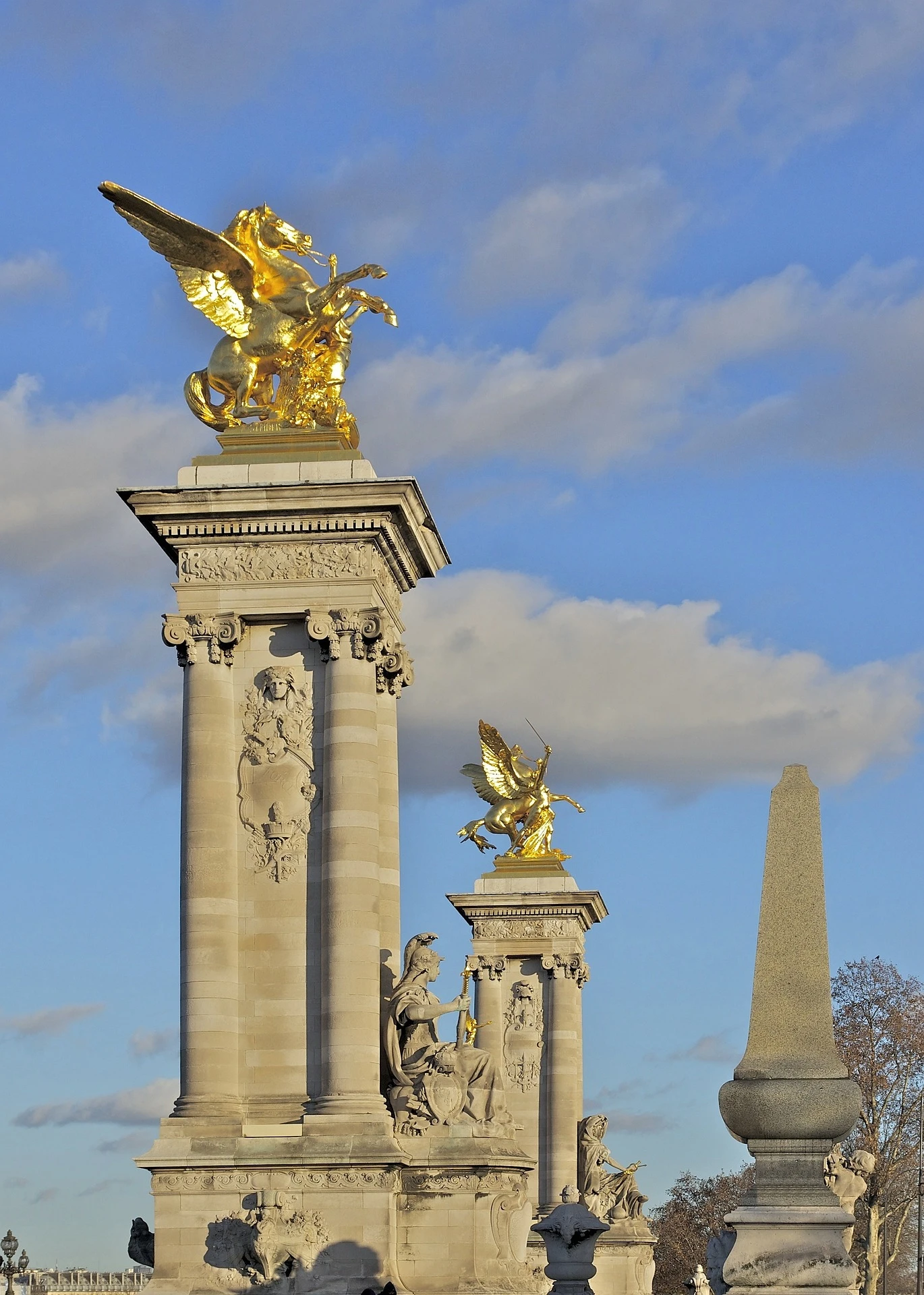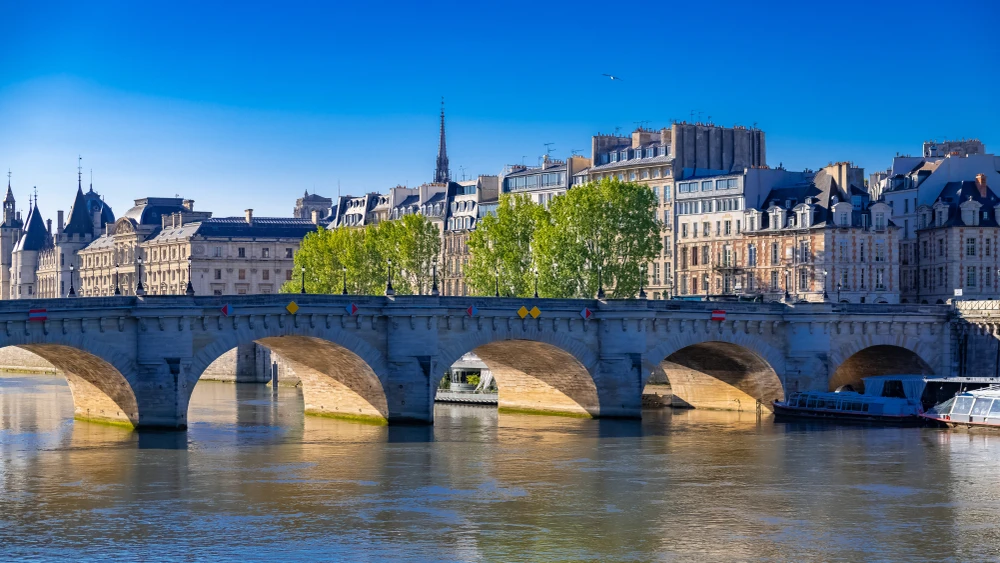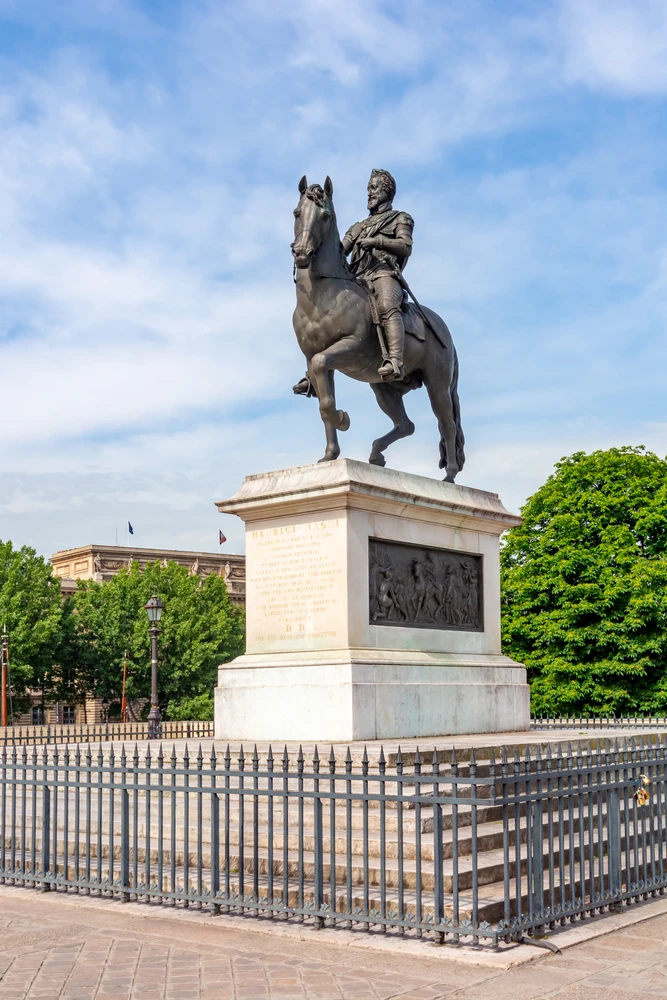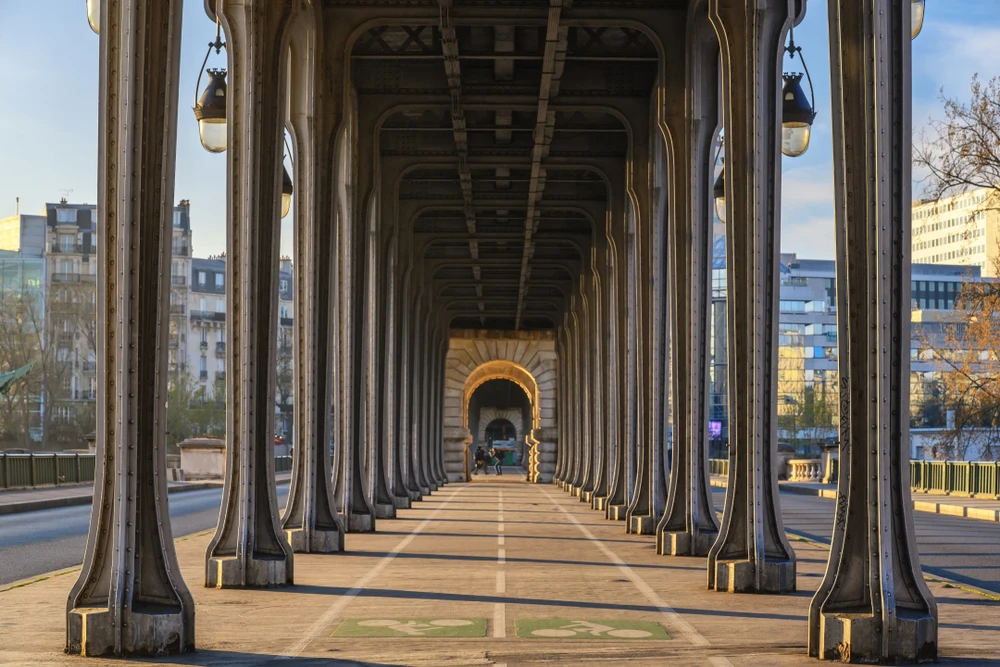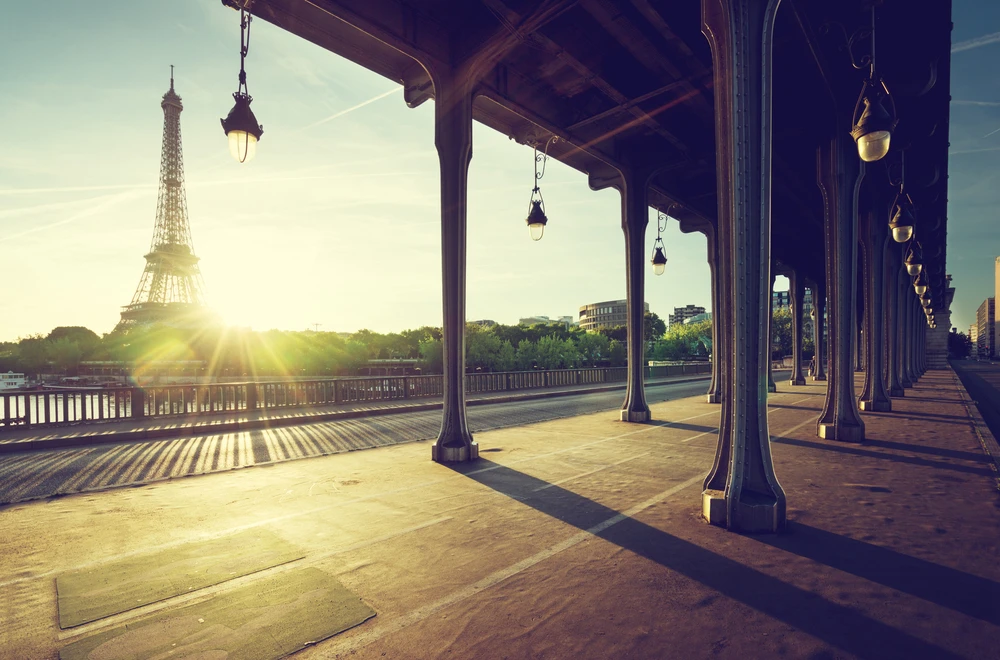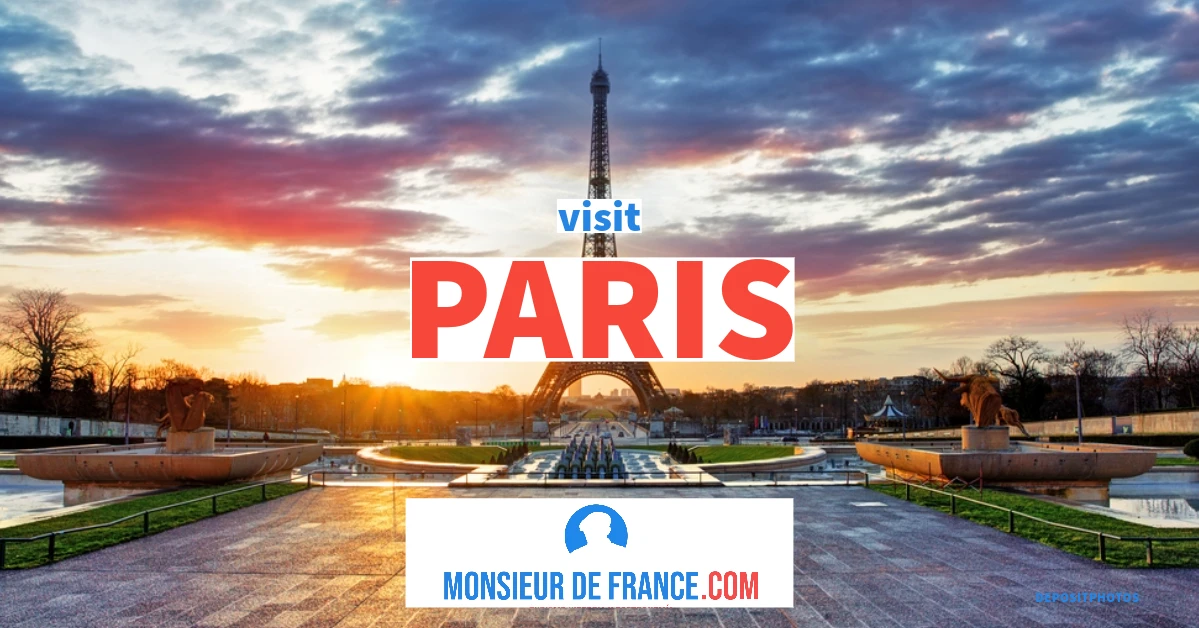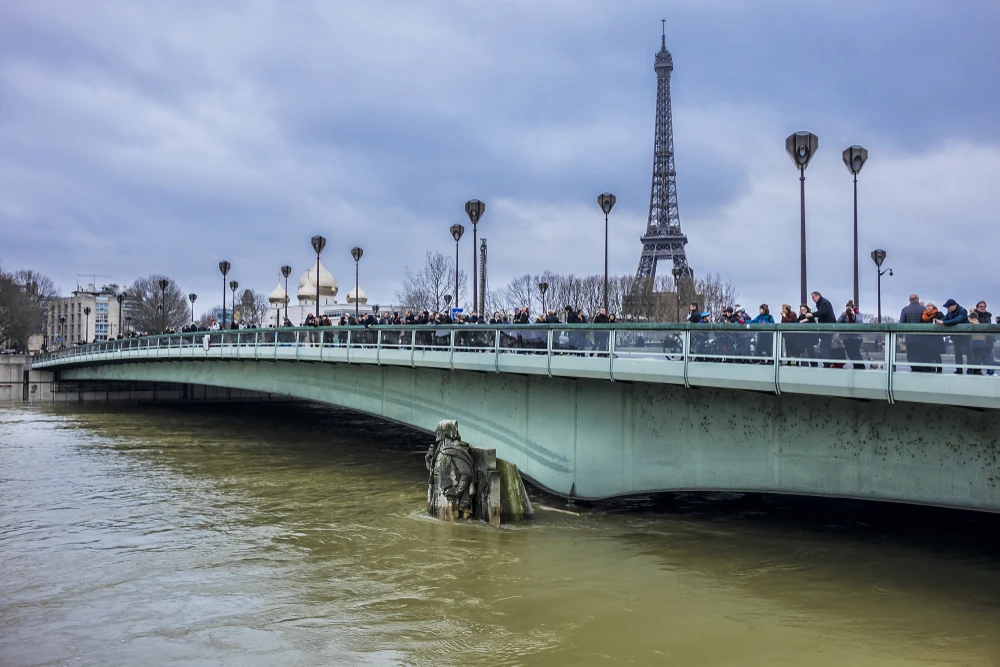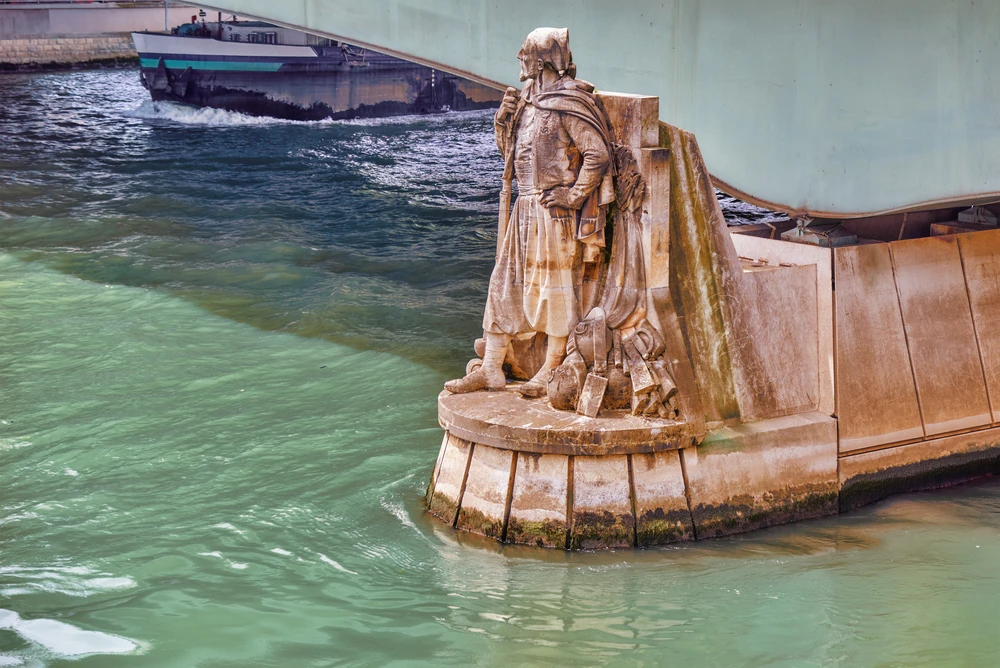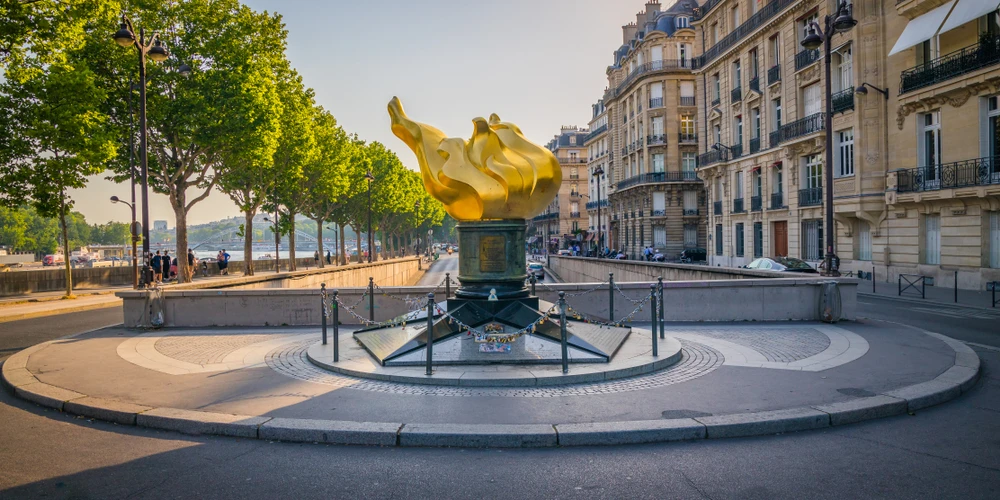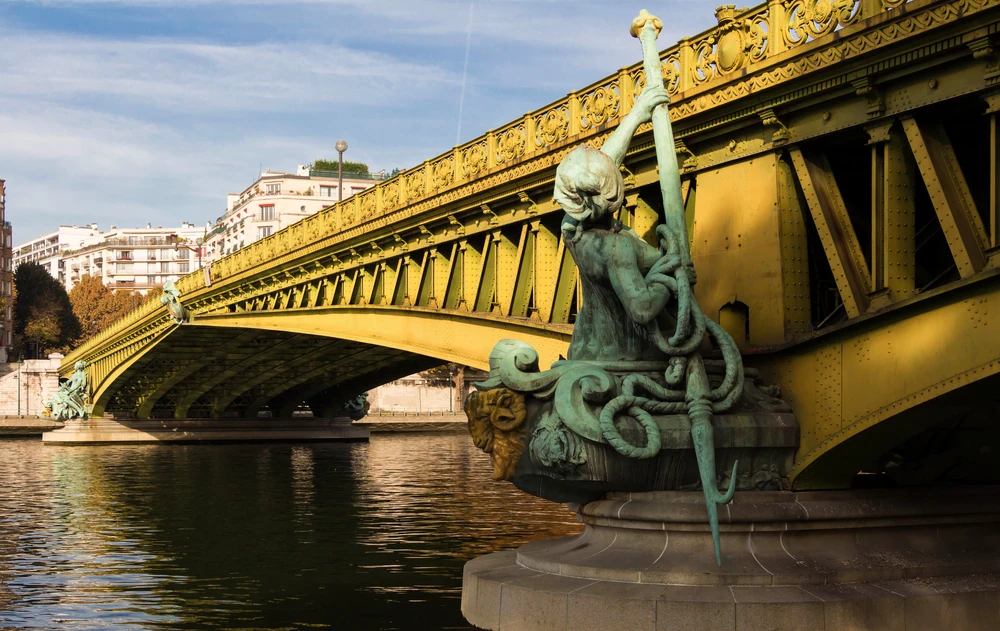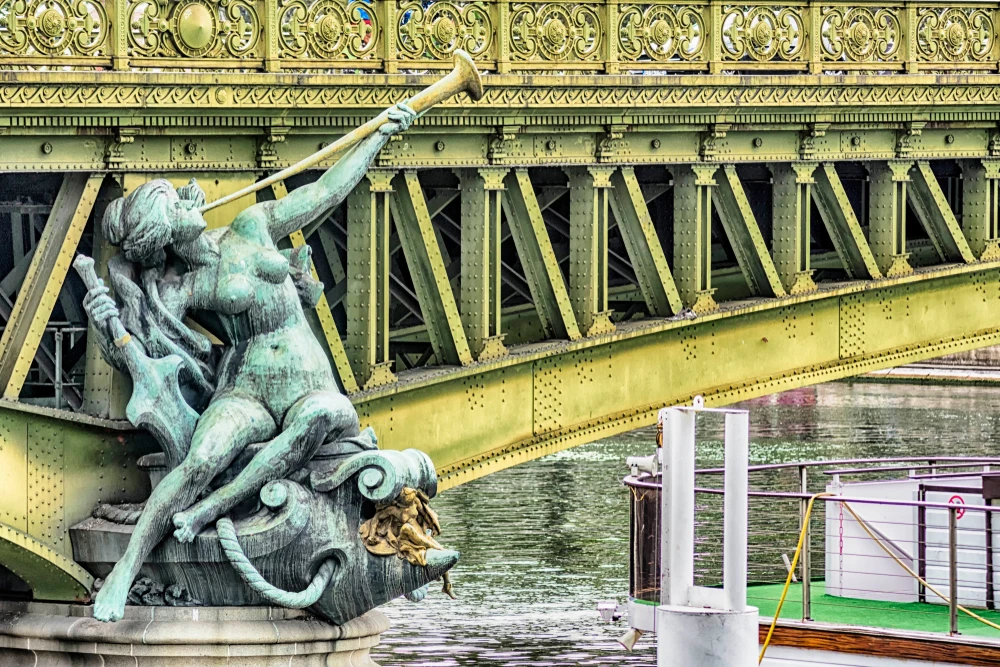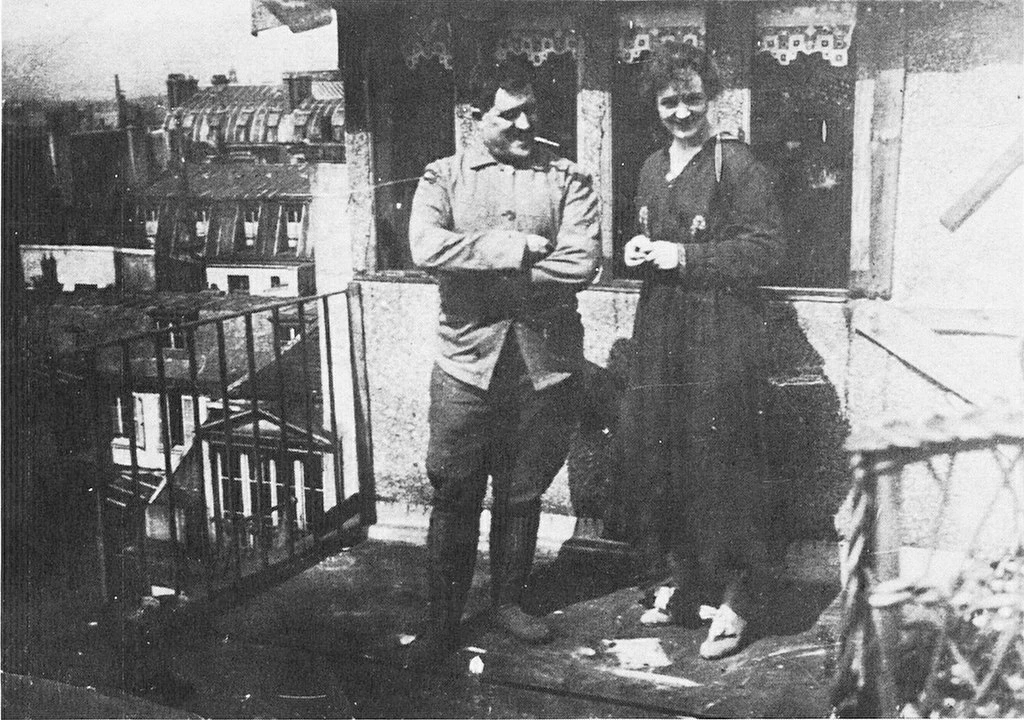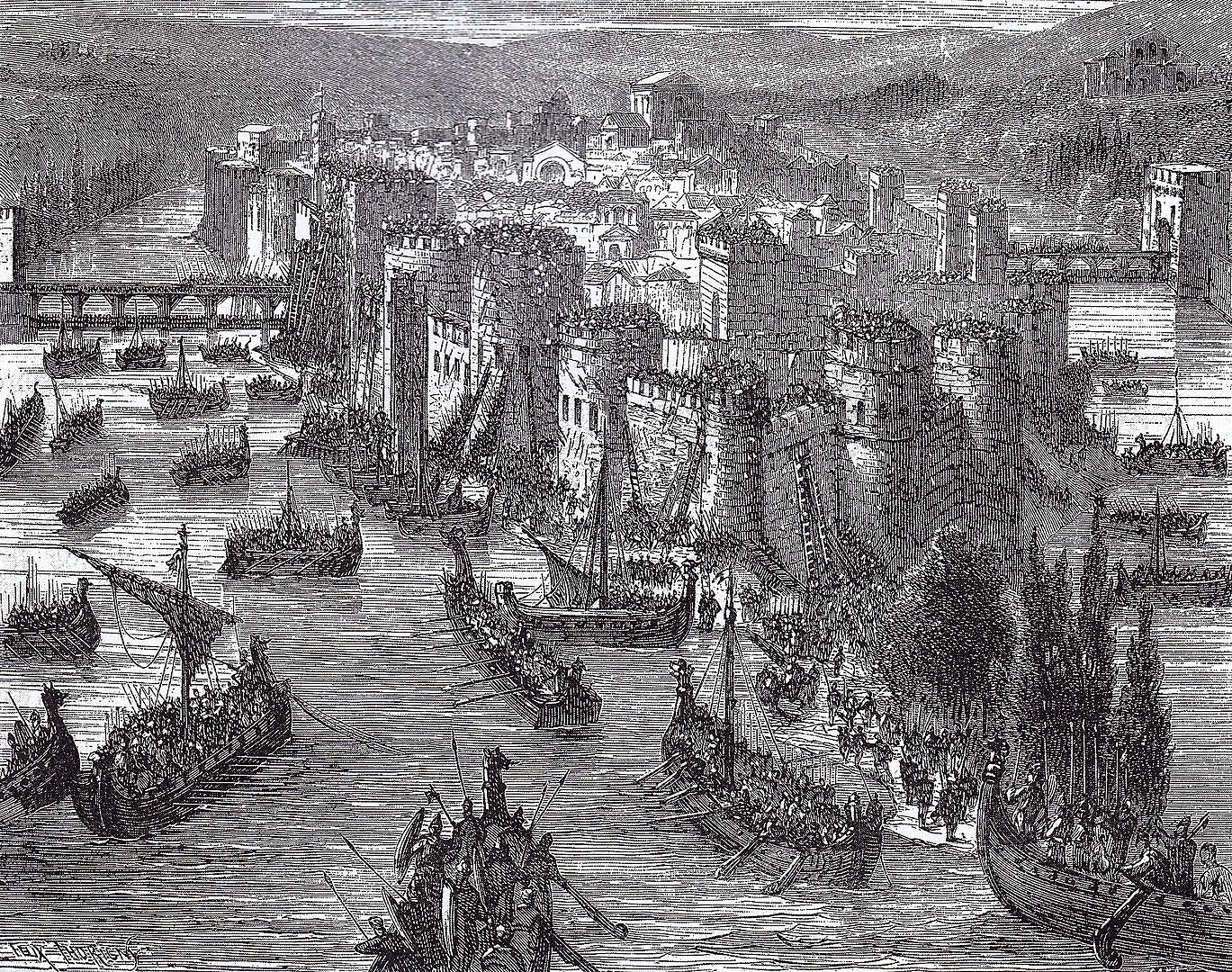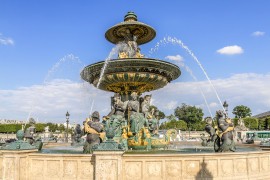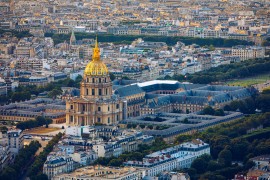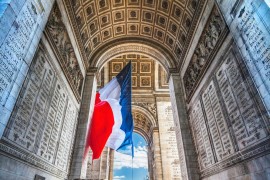TOP 5 of the most beautiful bridges in Paris
Choosing among all the bridges of Paris is obviously not easy, but Monsieur de France suggests you to discover 5 of them in priority. This does not mean that you should not go and see the others... Here is our selection.
1 : The Alexander III bridge
Beautiful Alexandre III bridge in Paris. In the background the invalids. Photo chosen by Monsieurdefrance.com : muratart/Shutterstock.com
Inaugurated on April 14, 1900, on the occasion of the Universal Exhibition, after 4 years of work, it is 154 meters long by 45 meters wide and connects the Invalides, which are revealed by the dome when arriving from the avenue Winston Churchill. It is decorated with 4 pylons of 17 meters high which represent the Renommée des Arts (right bank - upstream) the Renommée des sciences (right bank - downstream) by Emmanuel Frémiet (famous for having realized the statue of the archangel of Mont Saint Michel, or the statue of Joan of Arc in the Place des Pyramides in Paris), the Renommée au Combat (left bank - upstream) by Pierre Granet and "Pégase tenu par la renommée de la Guerre" (left bank - downstream) by Léopold Steiner and Eugène Gantzlin.
Pegasus on the Alexandre III Bridge Photo chosen by monsieurdefrance.com: David Mark from Pixabay
The bases of the pylons are also carved. We can see France in the Middle Ages, France in the Renaissance, France under Louis XIV and France Modene). At the entrance of the bridge, groups of lions and children welcome the passers-by.
Two motifs adorn the center of the arch, on one side the nymphs of the Seine surround the arms of the city of Paris, and on the other the Neva, Russian river, is accompanied by its nymphs and presents the arms of Russia .
Getting to the Alexander III Bridge
- Metro: invalides line 8 and 13
- REC: Gare des invalides RER C (rive gauche)
2 The "pont neuf"
The Pont neuf in Paris. photo chosen by monsieurdefrance.com : Pascale Gueret/ Shutterstock.com
You will be surprised but the Pont neuf (new bridge) is ... The oldest bridge in Paris. It was born from the will of the king of France Henri III who launched the works by laying the first stone on May 31, 1578. The revolt of Paris against the king postpones the concrete realization, which was suspended for a long time, and which is resumed by the will of Henri IV. The Pont-neuf was inaugurated in 1607. Its name has never left it even though it is more than 400 years old.
Some of the 381 sculpted mascarons of the Pont-neuf. We can clearly see the "bassines", these small balconies that once housed stores. Photo chosen by Monsieurdefrance.com : Todamo/ Shutterstock.Com
It is the 3rd bridge of Paris. It was very modern at the time of its construction since it was equipped with sidewalks, the very first in Paris, which allowed the pedestrians to "trot" quietly and thus not to poop themselves while walking on the muddy streets of Paris. It was decorated with 381 mascarons , all different from each other, a large part of which is still there. It was equipped with important cellars (which have since been blocked), and small stores that were installed in the "bassines", the overhangs of the bridge.
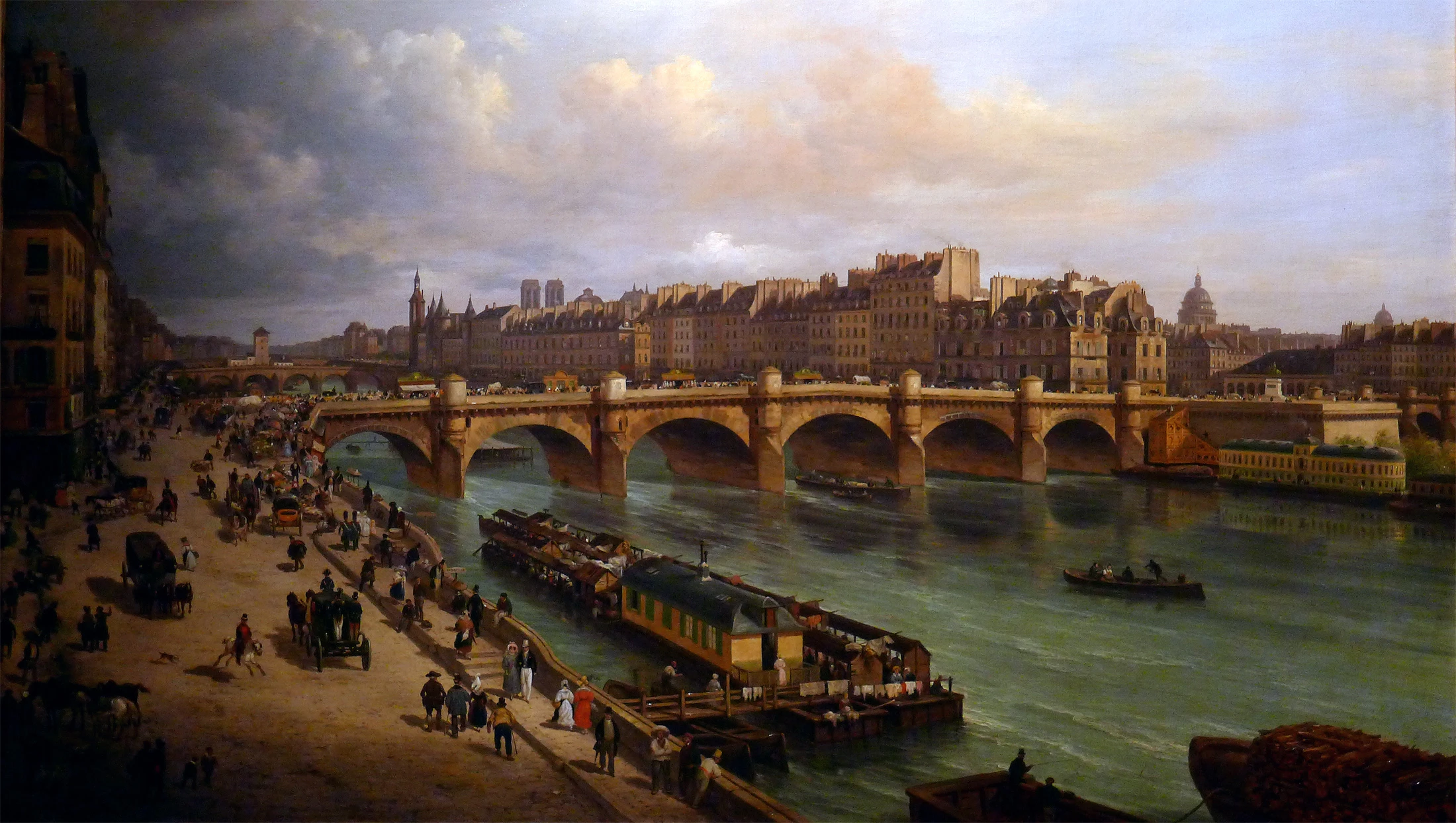 The Pont neuf in Paris in 1832 by Giuseppe Canella (Carnavet Museum)
The Pont neuf in Paris in 1832 by Giuseppe Canella (Carnavet Museum)
On the Pont-Neuf there were for a long time hawkers, book dealers, dog shearers and even parasol renters. In the 17th century, a gigantic pump was installed on the Pont-Neuf to supply water to many houses in the area. Named "la Samaritaine" (after the woman who gave water to Christ), it has since been destroyed. Its name has remained through the name of the large store "La Samaritaine" located nearby.
The equestrian statue of Henri IV on the Pont Neuf. Work of François Frédéric Lemot. Photo chosen by monsieurdefrance.com Mistervlad/ Shutterstock.com
From the Pont neuf, you can see the equestrian statue of King Henri IV. It replaces the original statue inaugurated in 1618 by the widow of Henri IV, Marie de Médicis. A statue made in Florence by John Bologna and Pietro Tacca and transported to Paris (the horse sank on the way, and it took a month to recover it in Savona). The statue of 1618 was melted down in 1792 by the revolutionaries to make cannons. The present statue was made in 1818 by François Frédéric Lemot (1777-1827). It is said that the Minister of the Interior of the time, the Count of Vaublanc, imposed himself as a model of Henri IV of whom he was a fervent admirer.
How to get to the Pont-Neuf
- Metro: Pont Neuf station line 7
- BUS: 21 24 27 38 47 72 74 75 85
3 The Bir-Hakeim bridge.
It is the most filmed bridge in Paris. We no longer count the films, photos, but also advertisements that have been made here. Built from 1903 to 1905, according to the plans of Louis Biette, it was called for a long time "the bridge of Passy" before becoming the "bridge of Bir-Hakeim" in memory of this battle which saw the Free French Forces resist against the Nazi forces in 1941 at Bir-Hakeim in Libya .
The Bir-hakeim bridge and its "Art Nouveau" columns. Photo chosen by monsieurdefrance.com : Noppasin Wongchum / shutterstock.com
Art Nouveau style, steel, two floors (the metro line 6 passes on the first floor), it is decorated with bas-reliefs at its entrances. On one side (upstream) science and work (made by Jules Coutan) and on the other (downstream) electricity and trade made by Jean-Antoine Injalbert. It measures 237 meters. It allows you to go to the Ile aux Cygnes, an artificial island of almost 900 meters long, on which stands the Statue of Liberty of Paris, a miniature version of its American sister, installed there in 1889 and made by Frederic Auguste Bartholdi. It is from the Bir-Hakeim bridge that you have one of the most beautiful views of the Eiffel Tower.
The most beautiful view of Paris on the Eiffel Tower is from the Bir-Hakeim bridge. Photo chosen by Monsieurdefrance.com : Iakov Kalinin / Shutterstock.com
Getting to the Bir-Hakeim Bridge
- Metro: Bir-Hakeim line 6
- BUS: 42 72 82
- REC C
4 The Alma bridge
The Pont de l'Alma when the water is high. In the center: the zouave. Photo chosen by Monsieurdefrance.com : Kiev.Victor / Shutterstock.com
It's not necessarily the most beautiful, but it's a very well known bridge for Parisians. First of all, it is the "flood" bridge. And for the whole world it is very close, in the Alma Tunnel, that Diana Spencer, Princess of Wales, died in a road accident. This bridge was built between 1854 and 1856 under the reign of Napoleon III (we owe to this emperor the almost total reconstruction of Paris by Baron Haussmann at the end of the nineteenth century, including the construction of the Paris Opera). There is almost nothing left of the original bridge, which was replaced in 1974 by a new Alma bridge, wider and therefore more functional for car traffic. From the old bridge, only one thing remained, the famous zouave...
The zouave of the Pont de l'Alma in Paris with dry feet in normal times. Photo chosen by monsieurdefrance.com: V_E / Shutterstock.com
Originally, the Alma bridge (named after the battle of the Alma on September 20, 1854 during the Crimean War against Russia), was decorated with 4 statues to pay tribute to the soldiers who had stood on the battlefield bringing the victory of the Alma to France. One could see a chasseur à pied, an artilleryman, a grenadier and a zouave. The Zouave, by his position above the water and his particular "look" has become a landmark for the rising waters of the Seine in Paris. When the water comes to lick his feet, trouble can begin, when it reaches his thighs, one can no longer navigate on the Seine which becomes impetuous. During the hundred-year flood of 1910, the biggest flood of the Seine to date, which flooded the whole center of Paris, the water reached the shoulders of the zouave. Even after the destruction of the original bridge, while the 3 other statues were dispersed in France (Vincennes, Dijon...) we kept the Zouave and the habit of observing him in case of rising water even if he is now a little lower than at the origin and that, especially, the height of the water is measured in a much more precise and official way at the Pont des Tournelles
The flame of the Alma tunnel. Photo chosen by monsieurdefrance.com : JeanLucIchard / Shutterstock.com
The place where Lady Diana died is located after the bridge. The entrance to the Alma tunnel is marked by a flame, which served as a place of remembrance for the British and fans of Lady Diana after the accident. This flame is in fact the double of the flame of the Statue of Liberty in New York, which is due to the French Frederic Auguste Bartholdi.
Getting to the Bir-Hakeim Bridge
- Metro: ligne 9 Alma-Marceau
- BUS: 72 73 82 92
- REC C
5 Le Pont Mirabeau
The Mirabeau bridge in Paris. Photo chosen by Monsieurdefrance.com: Petr Kovalenkov Shutterstock.com
It is one of the most pronounced bridges in France since it is at the head of a very pretty 1912 poem signed by Guillaume Appolinaire (the verses are actually engraved on the bridge). Built between 1893 and 1896, on the plans of the engineer Paul Rabel, with the help of Jean Résal and Amédée Alby.
It consists of 3 arches, the largest of which is 93 meters. It is decorated with statues made by Jean Injalbert (who also worked for the Bir-hakeim bridge). They represent the city of Paris, navigation, abundance and trade.
The poem of Guillaume Appolinaire is very beautiful. Here it is:
Under the Mirabeau bridge flows the Seine
And our loves
Must I remember
Joy always came after sorrow
Vienna the night sounds the hour
The days are going I remain
Hands in hands let's stay face to face
While under
The bridge of our arms passes
From eternal glances the wave so weary
Vienna the night sounds the hour
The days are going I remain
Love goes away like this running water
The Mirabeau bridge in Paris. Illustration chosen by monsieurdefrance.com: dimm3d /shutterstock
Love goes away
How slow life is
And how violent Hope is
Vienna the night sounds the hour
The days are going I remain
Days pass and weeks pass
Neither time passed
Nor loves come back
Under the Mirabeau bridge flows the Seine
Vienna the night sounds the hour
The days are going I remain
Guillaume Apollinaire, Alcools, 1913
Guillaume Appolinaire and his wife Jacqueline in Paris in their apartment in St Germain / photo chosen by monsieurdefrance.com: Bibliothèque nationale de France.
Getting to the Mirabeau Bridge
- Metro: Beaugrenelle station line 10
- BUS: 38 42 62 72
- REC C
But also:
Paris has 37 bridges over the Seine. And, of course, each one has its own style and may appeal to one or the other of you. The Pont des Arts, which leads to the Institut de France is very poetic. The Concorde bridge, discreet and elegant, allows to reach the National Assembly (and vice-versa) from the Place de la Concorde at the bottom of the Champs-Elysées. Much further on, the Bercy bridge is one of the largest in Paris (the largest bridge is the Aval bridge, with 312.50 meters, but it is entirely automobile since it is located on the Paris ring road).
A brief history of the bridges of Paris
There have not always been bridges in Paris. In Gallic times, Paris was an island in the middle of the Seine (which was naturally well protected) and people crossed the river by boat. The Gallic Parisii, who gave their name to Paris, made a specialty of transporting goods on the Seine. Called"nautes", their memory remains in the coat of arms of Paris, which includes a nef (a boat) and the motto "fluctuat nec mergitur" that is to say "it floats but does not sink" .
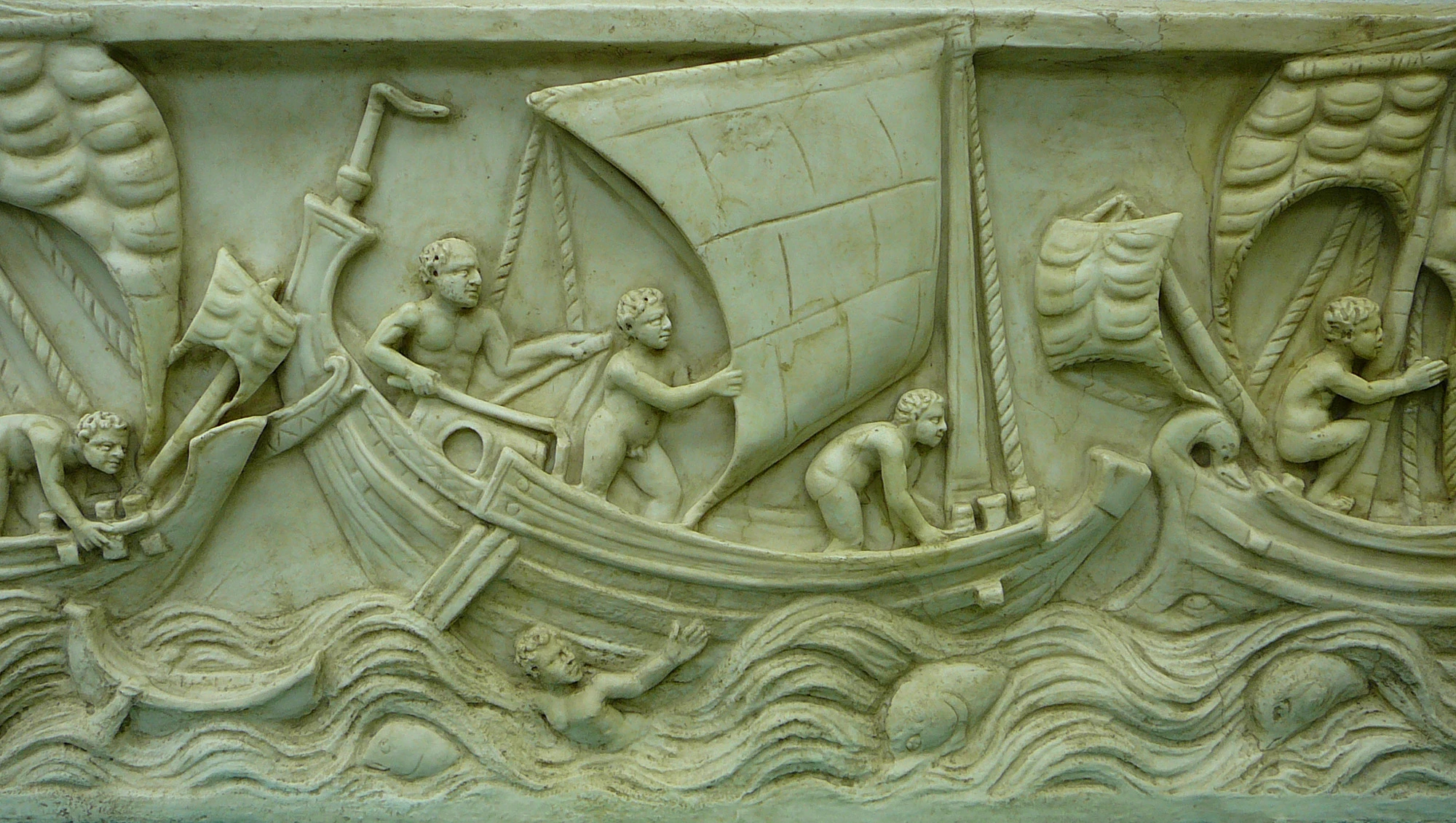 A Roman trading ship in the 3rd century. Illustration chosen by Monsieurdefrance.Com: Gun Powder Ma - Personal work, CC BY-SA 3.0, https://commons.wikimedia.org/w/index.php?curid=4595340
A Roman trading ship in the 3rd century. Illustration chosen by Monsieurdefrance.Com: Gun Powder Ma - Personal work, CC BY-SA 3.0, https://commons.wikimedia.org/w/index.php?curid=4595340
The first bridges
It was probably the Roman Gallos who built the first two bridges at the beginning of our era when the city of Lutetia overflowed onto the left bank of the Seine. The siege of Paris by the Vikings in the year 885 tells us that there was a small and a large bridge which were destroyed and rebuilt after the siege. The location of the small bridge is still the "small Cardinal Lustiger bridge" that we know today and which was built in 1850.
The siege of Paris in the year 845. illustration chosen by monsieurdefrance.com : Scanned from the german histrory magazine Der Spiegel Geschichte (6/2010): Die Wikinger - Krieger mit Kultur: Das Leben der Nordmänner. Spiegel-Verlag
The inhabited bridges
The bridges of Paris were inhabited for a long time and one could not see the river while crossing them. The Notre Dame bridge and the pont-au-change were used to cross the Seine and to change money or to make luxury purchases at the goldsmiths on the pont au change, hence its name. There were even monuments, like the one dedicated to the royal family under Louis XIV, which was destroyed in 1794. It was risky to live on a bridge in Paris. Capricious, the Seine has washed away the pont-au-change several times, causing many victims.
The Notre Dame bridge and its houses in 1576. illustration chosen by Monsieurdefrance.com : By Jacques Androuet du Cerceau
The "works" bridges
It is under Henri IV (1553-1610) and with the construction of the Pont-Neuf, that the bridges become the business of the State and become a way to assert its power in the capital. The more beautiful and spectacular the bridges, the more beautiful Paris is and the stronger France is. So we did not deprive ourselves of making some as our top 5 showed you...


